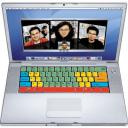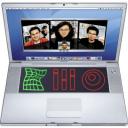End of the Keyboard
Lets review a few really awesome experiments with user-interfaces, and then I’ll introduce my own.
First, we have the Optimus Keyboard. Each key on this board has it’s own display. That means you can use the board for all sorts of wacky stuff. You could have the layout change adaptively for every key you press, or have a scrolling marquee that insults the user, or simplify language, layout, and font changes. The only drawback is that you can’t really re-arrange the physical layout of the keys.
Second, we have the Ergodex DX1 keyboard. It features individual keys with static-cling backing and a clear plate so that you place the keys exactly where you want them. The keys come with little stickers that you can use for labels, and you are free to design and print out nice looking backings. The major drawbacks here are that the system comes with a default of 25 keys and a 10� X 8� tray; this will not let you replace your current keyboard.
Idea 1: Why not have an inductor embedded in the tray (and make trays of several different dimensions) and have on the bottom of each key a set of 8 micro-switches, and on the top a tiny LCD panel? We then have the best of both worlds. The switches would encode the address of the key, which would be used to detect wether or not it was depressed, and what image it should display. The communication software would simply have to know about addresses, not physical locations, and the inductor could easily power it all.
Third, we have the Touchstream pads. These use the same technology that laptop track-pads use. The user presses a position on the pad and the keyboard maps that position into a key. The primary drawback here is that you no longer have great tactile feedback when you press a key, and that the keys are in fixed positions.
Finally, now that Apple and others have the Multi-touch, we can fully dispense with traditional keyboards. Imagine a multi-touch pad on each laptop instead of a regular keyboard. The location of each key could be fully customized, the glyph could change with each key press, everything you can do in Idea 1 above. Except now, since the keys aren’t physical, they could represent any control widget whatsoever, from sliderbars to joysticks. The possibilities are revolutionary.
 |

|
Update: Apparently musicians have already thought of something like this: the Lemur, it just hasn’t been extended to laptops.
Update: It was drawn to my attention that there already exist membranous keyboards with no push button tactile feel, rather they have a set of small ridges where an ordinary keyboard would have gaps between keys. These ridges provide enough feedback that the user can correctly reposition their hand and continually learn the keyboard layout by feel. Because tactile feedback is such a great loss to the touch typist, any multi-touch panel intent on replacing the ordinary board of keys should also be equipped with an upper surface that can raise little bumps.

Your idea, coupled with a 3D printer to give the keyboard some tactile ‘feel’, would be a good idea.
See here:
http://www.dimensionprinting.com/